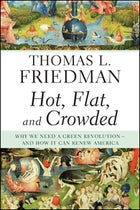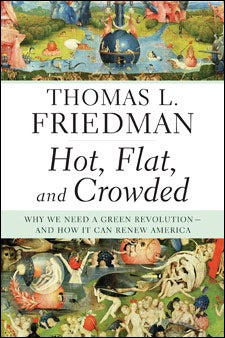THE WORLD HAS a problem, writes Thomas L. Friedman in Hot, Flat, and Crowded (Farrar, Straus and Giroux, $28), the none-too-cheery follow-up to his 2005 globalization primer, The World Is Flat. Temperatures are rising, countries like China and India are modernizing (read: “consuming more like the U.S.”), and population growth is off the charts. In short, the planet is ready to implode, and we have mostly ourselves to blame. But if we’re smart, he insists, America can work its way out of the crisisand even return to our status as a superpower. “Either we are going to rise to the level of leadership, innovation, and collaboration that is required, or everybody is going to losebig.”
Hot, Flat, and Crowded
 by Thomas Friedman
by Thomas FriedmanFriedman spends the first half of his roughly 450 pages detailing how we got into this mess, with a special shout-out to political leaders. “The prevailing attitude on so many key issues in Washington today is We’ll get to it when we feel like getting to it and it will never catch up to us, because we’re America,’ ” he writes. In the second half, he presents a smart, comprehensive but dauntingly ambitious plan for moving forward. The basics:?We need to build an ultra-efficient grid, or “Energy Internet”; increase demand for existing clean-energy technologies; and, most important, “spur the massive, no-holds-barred-everybody-in-their-garage-or-laboratory innovation we need [to find] new sources of clean electrons.” Those first two will require big-time tax incentives and regulations, he says. But his conservative fans won’t be disappointed: “The only thing that can stimulate this much innovation in new technologies,” he stresses,”is the free market.”
Most of these ideas aren’t new, of course; we’ve heard them from people like Al Gore and Arnold Schwarzenegger, both of whom are quoted herealong with dozens of otherpolitical, environmental, and corporate leaders. But Friedman’s knack for simplifying complex political and economic issues, combined with his chatty, if sometimes patronizing, style, make it one of the most accessible books yet on climate change and the energy debacle. We need a revolution, he stresses, not another marketing campaign. “A green brand, some green buzz, a green concert, and we’re on our way to solving the problem,” he writes. “Nota chance.”


